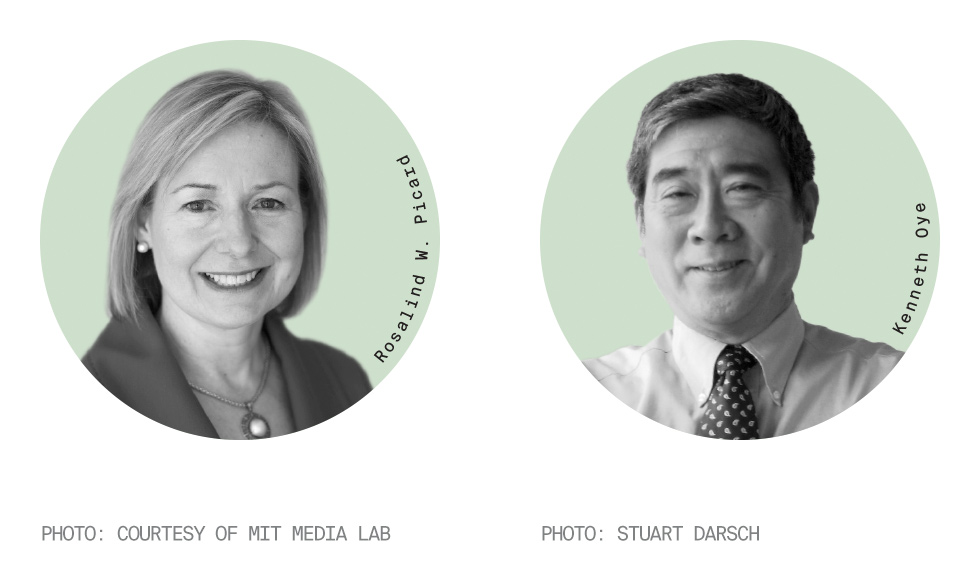
Empatica’s Embrace wristband has begun clinical trials for use in monitoring epilepsy.
PHTO: COURTESY OF EMPATICA
“While we still can’t measure your thoughts, and I think that’s a good thing, we can measure manifestations of them,” says Rosalind W. Picard ScD ’91, founder and director of the Affective Computing Research Group at the MIT Media Lab, and cofounder of Empatica, a company that sells wearable devices to medical researchers and to consumers for monitoring their personal health. “If you’re not getting good sleep or physical activity. If you’re not getting out of your dorm or apartment. Those can be early warnings that you’re physically sick or that your mental health is not where you want it to be.”
Wearable sensors are moving health care closer to personalized treatment regimens, real-time patient monitoring, and earlier detection of serious conditions. However, collecting data from new, unregulated sources that can reveal activity levels, mood, and more also raises questions about how all these data will be used.
“When people really understand your lifestyle choices, [will they] want to hire you or give you insurance?” asks Kenneth Oye, director of MIT’s Program on Emerging Technologies, who has spent decades studying and influencing technology policy.

Today, most consumer wearables are fairly limited, mainly tracking movement. The wearable sensors developed in Picard’s lab and by Empatica, however, use software that can track a much wider range of signals. In addition to gathering accelerometer data, these more sophisticated sensors can track gyroscope data, temperature, and skin conductance—from which researchers can derive heart rate, heart rate variability, respiration, and even posture. By collecting such data from a broad spectrum of people and combining them with user input (shared with permission) and advanced computer analytics, researchers are gaining a nuanced understanding of how the technology records different moods and behaviors.
“We are building tools that will allow people to see if behaviors in their life related to their physical activity, their stress, their sleep, are impacting their mood or not,” Picard says, noting that the devices often detect signs of stress before users do. “I liken it to your personalized weather forecast.”
Such information can prompt individuals to make behavioral changes, but there are wider benefits. Gathering and analyzing such data could help health care professionals to better personalize their advice, and manufacturers to custom-tailor drugs. “Why should you have to deal with a recommendation that is for some average group of people, when almost nobody is that average person?” Picard says.
Today, drug and medical device trials are designed to test how well a medication or device works for a broad population. “Randomized clinical trials are the ‘gold standard,’ but at the same time, they’re inherently imperfect predictors of how drugs will work in use,” Oye says, noting that to produce clear results, trials deliberately seek to eliminate sources of noise, including test subjects who are on medications or suffer from additional ailments—even though the world is full of such patients. Data from wearable sensors should make it easier to establish precise profiles of who is taking and benefiting from a new drug or treatment in real-world settings.
Already there is evidence that sensor data could save lives. Empatica’s Embrace wristband, which consumers may currently purchase to track their own physical data, has begun clinical trials for use in monitoring epilepsy. Picard says the device may be able to alert caregivers to the most dangerous kinds of seizures, and reveal that a patient is heading for a rare complication known as SUDEP (sudden unexpected death in epilepsy), which can occur after a seizure’s apparent end.
“An EEG on the scalp can look flat, as if the brain has shut down, and the person can look like they’re sleeping, but our sensor’s response on the wrist can be going through the roof. And that’s a warning that there’s something going on deeper in the brain that could possibly be taking their breath away shortly,” Picard says. At that point, an intervention as simple as a shoulder shake from a family member might save the person’s life.
At a more basic level, the electronics we carry with us already provide a tool for medical professionals to enhance patient care. “Doctors all say the hardest part of practicing medicine is behavioral. Physicians will tell us to do stuff, but we don’t,” Oye says. “Now the simple technology that we have in our phones and in other locations is being used by doctors and nurses to improve the quality of the practice of medicine by prompting follow-ups.”
However, Oye points out that such societal benefits need to be weighed against individual concerns about how all the data that can be collected will be used. “There are very strong concerns that the information that you’re providing could be used against your interests,” says Oye, who is also an associate professor of political science. While US law protects against discrimination by health insurers, such rules don’t currently apply to life insurance or disability coverage, he notes.
As a first step to address such concerns, both Oye and Picard recommend that technologists educate both the public and the policy-making community about the capabilities of wearable devices. “This is an area where relatively open access to the technologies developed, how they’re being used, is critical,” says Oye. “There’s a public interest in having information to be able to evaluate, and adapt, and adjust.”